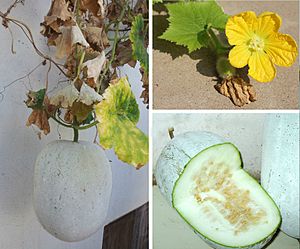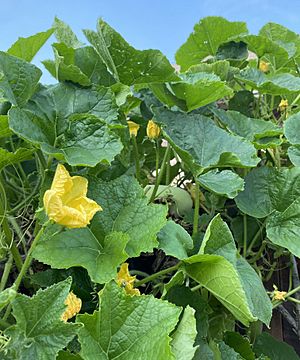Wax gourd facts for kids
Quick facts for kids Wax gourd |
|
|---|---|
 |
|
| Wax gourd plant, flower and immature and mature fruit | |
| Scientific classification | |
| Genus: |
Benincasa
|
| Species: |
hispida
|
| Synonyms | |
|
List
|
|
| Nutritional value per 100 g (3.5 oz) | |
|---|---|
| Energy | 54 kJ (13 kcal) |
|
3 g
|
|
| Dietary fiber | 2.9 g |
|
0.2 g
|
|
|
Protein
|
0.4 g
|
|
Link to USDA Database entry
|
|
| †Percentages estimated using US recommendations for adults. | |
The wax gourd, also known as ash gourd or winter melon, is a large fruit grown on a vine. People eat it as a vegetable when it is fully grown. Its scientific name is Benincasa hispida. It is the only plant in its group, called Benincasa.
When the wax gourd is young, it has a fuzzy coating of fine hairs. The inside flesh is thick and white, and it tastes sweet. As the fruit gets older, it loses its hairs and grows a waxy coating. This wax gives it the name "wax gourd" and helps the fruit stay fresh for a long time, sometimes up to a year! These gourds can grow very big, up to 80 centimeters (about 31 inches) long. The plant has yellow flowers and wide leaves.
The wax gourd originally comes from South and Southeast Asia. It is now grown widely across Asia, including places like Java and Japan.
One special type of this plant is called chi qua. It is often used in Asian cooking.
Contents
What's in a Name?
The name "winter melon" comes from the Chinese name dōngguā. In Chinese, the word 瓜 can mean "gourd," "squash," or "melon." People might call it a "melon" because it is sometimes made into sweet candies or a sweet tea.
How Wax Gourds Grow
Wax gourds grow best in warm, mild places. They need soil that drains well, like loam or sandy soil. They cannot handle frost, which is freezing weather. Farmers often plant them in riverbeds or special rows called furrows. They also need a lot of water while they are growing.
How People Use Wax Gourds
The wax gourd can be stored for many months, similar to how winter squash is kept. In some parts of India, ash gourds have a white, rough coating. Varieties from Southeast Asia have a smooth, waxy feel. It is one of the few vegetables available during winter in areas where trees lose their leaves.
In Cambodia, the wax gourd is called tralach. It is used to make soups and stews in Cambodian cuisine. A common dish is samlor tralach, which is a soup made with winter gourd and pork.
In Chinese cooking, wax gourds are used in stir-fries. They are also cooked with pork or pork/beef bones to make winter gourd soup. This soup is often served inside a hollowed-out gourd, which is carved by scraping off its waxy coating. The gourd is also chopped and made into sweet wintermelon candy. This candy is often eaten during Chinese New Year celebrations. It is also used as a sweet filling for Sweetheart cake and in Chinese and Taiwanese mooncakes for the Moon Festival.
In Vietnamese cuisine, the wax gourd is called bí đao. It is usually made into soup or stew. When cooked with pork ribs, people traditionally believe the soup helps mothers produce more milk for breastfeeding.
In the Philippines, the candied wax gourd is called kundol. It is used as a filling for pastries like bakpia (known as hopia in the Philippines). It is also an ingredient in some savory soups and stir-fries.
In Indian cooking, wax gourds are used in many dishes. In northern India, it is made into a candy called petha. In South Indian cuisine, it is used to make different curries, including a stew with a yogurt base. The juice from raw ash gourd is used by some communities in North-East India as a natural way to treat mild stomach problems. In the Himalayas, it is sometimes mixed with crushed moong to make a dish called bori. When dried in the sun, it becomes hard and is used in curries with rice or chapati. This is common in the Himalayas because the dried gourd lasts a long time.
In Andhra Pradesh, it is called Boodida Gummadikaya (Telugu). It is used to make stews, stir-fries, and vadialu. Vadialu are made by chopping the gourd into small pieces and mixing them with ground urad beans and spices, then drying them in the sun. To eat them, vadialu are deep-fried and served with rice and sambar or lentil stews.

In Kerala, the plant is called Kumbalam and the fruit is called Kumbalanga or Kooshmandam. It is sometimes used in traditional ceremonies. Instead of offering an animal, an ash gourd is cut in half with a sword as a symbol.
In Karnataka, the ash gourd is known as Boodu Kumbalakaayi (Kannada) and Boldu Kumbda in Tulu. It is used to make dishes like Kodel (Sambhar), Ale bajji, Kashi Halwa, and chutney. It is also widely used during festivals like Dasara for religious offerings.
In Maharashtra, the ash gourd is called Kohalaa in Marathi language. Kohala is used to make a sweet dish called Kohalyachi Vadee (Burfi) and also in Sambhar.
In Gujarat, it is called kolu.
In Bengal, it is called "ChaalKumro". Many dishes are made with it, such as ChalKumro’r Bora, Chalkumro ghonto, Chalkumror dudh curry, and Chal kumro with mung dal.
In Nepal, it is called Kubhindo. Young gourds are cooked as a vegetable. Ripe gourds are usually made into sweet preserves or crystallized candy called "murabba" or "petha".
Sometimes, wax gourd is used to make a fruit drink with a special taste. It is usually sweetened with caramelized sugar. In Southeast Asia, this drink is sold as wax gourd tea or wax gourd punch.
The young shoots, tendrils, and leaves of the plant can also be eaten as greens.
Hindus also use the ash gourd as an offering in some religious ceremonies, as a symbol instead of an animal sacrifice. The gourd is marked with red powder and cut in two with a sword.
Mystery Seeds of 2020
In the summer of 2020, people in several states across the U.S. received strange packages in the mail. These packages contained unknown seeds, and many of the envelopes had Chinese writing on them. At least one person planted some of these seeds. The plant grew and was identified as Benincasa hispida, the wax gourd, before officials removed it.
Images for kids
-
Chinese winter melon soup
See also
 In Spanish: Calabaza china para niños
In Spanish: Calabaza china para niños












